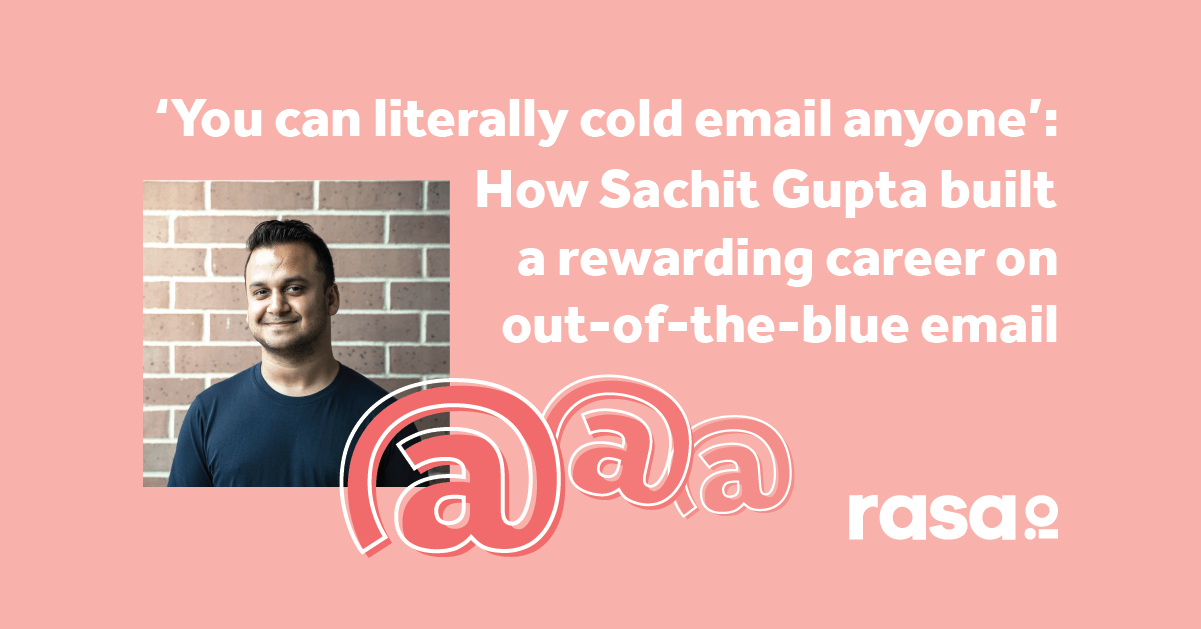Imagine cold emailing your way into working with a dream client. That’s exactly what marketer Sachit Gupta did back in 2012.
At the time Gupta was a big fan of entrepreneur-turned-podcaster Andrew Warner and Warner’s podcast Mixergy, which had gained a giant following for its content digging into the experiences and learnings of startup leaders. Gupta was spending hours each day watching Mixergy interviews with entrepreneurs. So, he sent Warner an email with a straightforward subject line: “Andrew, I’d love to help you with Mixergy.”
Gupta didn’t expect a reply, but he got one.
“I was really excited to get a response from Andrew. Also, there was a reluctance to celebrate because I didn’t know what it would turn into,” Gupta said.
The email led to a call. That led to a few more calls and emails. Eventually Gupta and Warner started working together. Eight years later, Warner remains a client, Gupta said.
When it comes to building connections, email is the great equalizer, Gupta said.
“You can literally cold email anyone,” he said.
Gupta emphasizes that a really great cold email is a launching point. There is plenty of rejection in the tactic. For those emails that do get a response, it takes time to develop a meaningful connection. You have to be patient, Gupta said.
“You’re sending that cold email and you might have a call, but relationships like that will sometimes take much longer to develop,” Gupta said. “You want to go into it not wanting to play the short game. That’s where everyone [else] is.”
Gupta gave an inside look at his approach to cold email on a recent episode of rasa.io’s Pushing Send podcast. Here are his tips for crafting a message that resonates.
1. Email a person, not an account
Sending a cold email to a general info account or a welcome account is a surefire way to get a zero response. Gupta recommends taking time to research the email address for the specific person you want to contact.
“It’s really easy to figure out someone’s email address,” Gupta said.
Most companies have the same email format for all employees. Gupta searches for emails based on simple first name/last name format or first initial/last name formats until he lands on the right email. “There’s like 10 different variations,” Gupta said.
Another good channel for direct outreach? LinkedIn. Users can receive a direct message from other users, which makes it nearly as valuable as having a specific email address, Gupta said.
2. Get to the point
Be short and direct when crafting a cold email. And be helpful. Write about what you can do for the person you are writing to, Gupta said.
“Always make it focused on the person and how you can add value to them,” Gupta said.
That approach applies to your subject line as well as the body of the email. Gupta points to the email he sent to Andrew Warner about work with Mixergy. His subject line—Andrew, I’d love to help you with Mixergy—was as transparent as possible.
“I was making it really clear what the intention is,” Gupta said.
The first paragraph in that email stated why Gupta wanted to work with Warner. The next line briefly outlined what he had done up to that point in his career.
He closed with this line: “I can either bring you new ideas of things to do or help you execute the ideas you already have. We can discuss this with each other, of course.”
The focus should remain on the other person and what you have to offer them, Gupta said.
3. Create an escape hatch
Cold emails are awkward. Most cold emails end in rejection and that makes people uncomfortable, especially if they’re the ones doing the rejecting. Build in a way for the recipient to politely refuse your offer, Gupta said.
Gupta typically ends his cold emails with a line like this: Is this something you’d be interested in? No hard feelings, if not.
This simple addition helps ease potential awkwardness, and gives the recipient an outlet for ending the conversation without coming off as a jerk.
4. Keep it short
Cold emails should never—repeat never—go long. Getting the point across in a few sentences demonstrates that you have intent and are respectful of the recipient’s time. It also makes it harder for you to turn the focus to yourself, Gupta said.
“A lot of people will send a long email letter just talking about themselves,” Gupta said. “Those are the ones that don’t get responses.”
5. Picture your reader
Gupta’s technique for writing short, but personal email? Picture the person you’re writing to as they’re opening and reading your email. Better yet call up their picture on the screen as you’re writing. It’s a reminder that you’re writing to an actual person that has a life and family and interests, Gupta said.
Gupta recalls writing a marketing email series that targeted podcasters. He printed and taped small pictures of five podcasters at the top of his laptop to watch as he worked. Having their images there was a good visual reminder to keep the email personal, he said.
“Whatever I’m writing is kind of addressed to those specific people,” Gupta added.
The takeaway? The best cold emails (and email content marketing, in general) always has a personal touch. Take the time to make your writing thoughtful and specific, and good results will follow.













